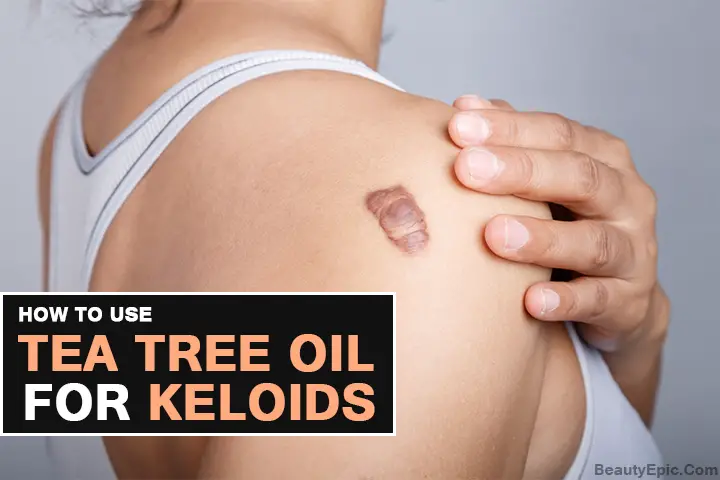
Important: This article is for informational purposes only. Please read our full disclaimer for more details.
Wounds are usually surrounded by scar tissues and overgrowth of scar tissues is known as keloid. Keloids derive their name from crab claw which is termed as keloids, as they grow sideways. Keloids usually show up after the skin is infected after the formation of boils, body piercings, sunburns, and surgical wounds. The scars called keloids are said to be more common in people who have more melanin content or darker skins. Here we explain in detail on how to use tea tree oil for keloids treatment. Have a look!
Article Contains
Does Tea Tree oil Help Keloids?

- Tea tree oil is primarily composed of terpinen-4-ol and alpha and gamma terpinene.
- These attribute to the anti-bacterial, anti-fungal and anti-viral properties of tea tree oil.
- Tea tree oil is also anti-inflammatory in nature and can be used as an antiseptic.
- Due to the anti-inflammatory properties of tea tree oil, it is helpful not only in relieving pain caused by keloids but also in preventing the occurrence of keloids.
- It is effective in inhibiting keloids formation and reduces itching.
How to Use Tea Tree oil for Keloids
Although keloids are not dangerous, their presence may be painful and there are chances of reappearance too. A number of skin ointments and other oral treatments are available to cure keloids, however using a simple and safe-to-use home-based remedy avoids any side-effects caused by the use of chemicals. One of the options is the use of tea tree oil. Tea tree oil is used as an essential oil for curing a number of skin ailments and here we shall discuss its use to treat keloids.
1. Tea Tree oil Treatment for Keloids
You’ll need
- tea tree oil
- cotton ball
Preparation time: 2 minutes.
How to do
- If not allergic to tea tree oil, then tea tree oil can be applied directly on the keloid scars.
- Just dip a cotton ball in tea tree oil.
- Gently rub the cotton ball soaked in the oil on the scars.
Repetitions: This can be done as many times as desired.
[ Read: How to Use Tea Tree oil for Skin Tags ]
2. Tea Tree oil and Vitamin E for Keloids

You’ll need
- tea tree oil
- vitamin E oil
Preparation time: 3 minutes.
How to do
- Mix tea tree oil with an equal concentration of vitamin E oil.
- Take a sterile cotton swab and dip it in the oil mixture.
- Drain excess oil and apply this on the affected area gently.
Repetitions: Repeat this process twice or thrice a day until the keloids start to heal.
3. Tea Tree oil and Sea Salt for Keloids
You’ll need
- 2-3 drops of tea tree oil
- 1 glass of warm distilled water
- 1 teaspoon of sea salt
Preparation time: 4 minutes.
How to do
- Take 2-3 drops of tea tree oil.
- In a glass of warm distilled water, add half a teaspoon of sea salt and the drops of tea tree oil.
- Soak the affected area in this liquid for 10-15 minutes.
Repetitions: This can be done every day before going to bed till the keloids heal.
Tips and Precautions
- Although tea tree oil is considered a safe and effective method to cure keloid scars, it is always advisable to do a patch test on the skin with tea tree oil to avoid further infections or allergic reactions caused by tea tree oil.
- Tea tree oil is considered toxic when ingested orally. If anyone ingests it orally, take them to the doctor immediately.
- The concentration of tea tree oil used always needs to be monitored to avoid further allergies.
- Excessive use of tea tree oil can cause rashes, itching and redness of the skin.
You Might Also Like
- How to Use Tea Tree Oil for Fever Blisters
- Tea Tree Oil for Herpes How Effective Is it?
- How to Use Tea Tree Oil for Head Lice
- How to Use Tea Tree Oil for Ringworm
Image:- 1















